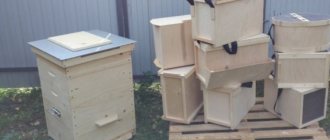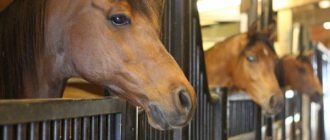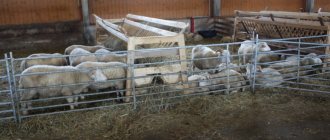If you are a beekeeper, then you know how to maintain your hives and take care of your bees. Sometimes situations arise when you need to move hives from their current location. For those looking to move their hives, this step will require a lot of advance research and planning. And the main thing you need when transporting them is a high-quality and safe trailer. How to make an inexpensive and reliable trailer for transporting beehives with your own hands.
Advantages of using trailers in beekeeping
The simplest device for the owner of a nomadic apiary is considered to be a cart for transporting bees, attached to a passenger car. The vehicle allows the transportation of a small number of houses. The owner of a large nomadic apiary benefits from a spacious platform.
The advantage of using a towed device for transporting hives is explained by the advantages of a nomadic apiary:
- The nomadic method of maintaining an apiary promotes better development of bees in mid-spring.
- Transporting hives to another location benefits the bees. Insects gain access to the required amount of nectar.
- For nomadic apiaries, the honey collection season begins earlier and ends later. Transporting bees to flowering honey plants brings the beekeeper more harvest. The purchase of a trailer and fuel for transport will pay off if you collect at least 6 kg of high-quality honey from each hive.
- During transportation of the apiary, the beekeeper independently chooses which honey plants to stop near. Frequent migration allows you to obtain different varieties of honey during the season.
If we talk about the advantage of the towing device itself, then small carts for passenger cars are advantageous in terms of compactness. However, the downside is the capacity. Typically, a standard passenger trailer can transport a maximum of 4 hives with bees at a time.
Large trailers called platforms have many advantages:
- During transport, vibration on the hive platform is minimal compared to a small trailer. The bees do not get stressed and behave calmly upon arrival at a new place.
- When transporting a hive by cart, it must be unloaded and loaded. There are always houses with bees on the platform.
- Due to the stability and high sides, the platform transports a large number of hives installed in several tiers.
Having a trailer or platform for the beekeeper is always a big plus. Non-export bees bring little honey. Families weaken and die over time.
Advice! During the season, the apiary must be taken to the field at least once. There will be no use for hives standing in the yard.
Useful tips for beekeepers
Tips from experienced beekeepers:
- It is inconvenient to wander alone, so it is better to join a group.
- Before transportation, you must select a location for the apiary. Sometimes transportation can be carried out 500 km from home, but do not be afraid of such long distances - after all, the costs will be paid off by high-quality honey collection.
- To choose the right place for an apiary, you need to contact the district livestock specialist, and also obtain permission to place the apiary from the owners of the state farm. Installing an apiary in the forest will require permission from the forestry department.
- After the honey harvest, the bees become stronger and their anxiety increases. The combs contain a large amount of unripe honey, which leads to increased humidity in the middle of the nest and the risk of comb breakage. To prevent a tragedy, when moving, you need to remove the frames filled with honey and insert empty ones instead.
- When transporting in the spring, when the bee colony is not yet strong and the nest contains a small amount of honey, it is necessary to lay a clean canvas over the frames, clamp it with strips and hammer it with nails, which will provide protection from the cold.
- When transporting in summer and autumn, loose burlap should be stuffed onto the sides of the beehives. If the house does not contain sides, empty frames must be placed on it, onto which burlap must be nailed. The material serves as ventilation and does not let in much light, thereby preventing the temperature inside the nest from rising.
Transportation of bee colonies to tracts of honey-bearing plants allows obtaining high-quality and high honey collection. The apiary roaming is carried out using special trailers, which allow bee colonies to be quickly and reliably moved to the place of nectar collection. Building such a trailer with your own hands will require time and effort, but as a result you will get a lot of tasty, aromatic and healing honey from your bees.
Types of trailers for transporting hives
There are many types of homemade and factory trailers used for transporting bees. Based on their design, they are conventionally divided into three groups: carts for passenger cars, platforms and pavilions.
Beekeeping trailer for a car
There is a beekeeper's car trailer of a specialized design and a homemade version modified by a beekeeper. In the first case, the towing device is adapted from the factory for transporting beehives. In the second option, the beekeeper himself remodels the trailer.
The standard model, for example, for a Zhiguli car, holds 4 hives. You can increase the sides by installing 8 houses in two tiers. If there are a lot of horses under the hood, beekeepers expand the frame and adapt a platform with a retractable mechanism. A good option is a bee trailer for a UAZ car for 25 bee colonies, which allows you to transport an average apiary at a time.
Advice! An extendable trailer can be adapted to transport a small apiary without removing the hives from the platform at the point of arrival.
Platforms for transporting bees
In fact, the platform is also a trailer, only more spacious. The design is usually biaxial. When transported in 2 tiers, you can accommodate up to 50 hives. A single-tier apiary is usually not removed from the platform. The hives are in their place. There are large platforms that can accommodate more than 50 hives. If desired, the structure can be improved with a roof.
Pavilions
There are stationary and mobile pavilions. In the first case, the structure is installed on the foundation. A mobile pavilion is similar to a platform, but is equipped with a roof, walls, and a door. The hives stand outward in several tiers, and this is where they overwinter.
Mobile cassette pavilions are convenient to use. The bees live in special modules that make maintenance easier for the beekeeper.
How to make a bee trailer with your own hands
A conventional single-axle trailer for transporting bees for a passenger car can be improved by extending the sides. Removable roof racks can be accommodated. To capture more hives in one shipment, the frame will have to be expanded. It is advisable to add a second axis. The entire process of manufacturing a trailer hitch consists of assembling the frame and its covering.
Drawings, tools, materials
They begin to make a trailer for hives by drawing a drawing. Initially determined with dimensions. When choosing dimensions, it is important to take into account the traction force of the vehicle so that it can cope with the load. An example of a finished drawing can be easily found in various sources. You can customize your sizes. It is important to remember that the trailer will have to be transported to the apiary along the highway. Its dimensions should not interfere with the movement of vehicles.
The materials used are sheet metal, pipe, profile, corner. Tools include a grinder, a drill, a welding machine, a hammer, pliers, and wrenches.
Build process
They begin to assemble a trailer for transporting bees with their own hands by planning the location of the hives. The location of the houses is marked on the drawing, from here the size of the frame is determined. The further process consists of the following steps:
- According to the drawing, a frame is welded from a profile, angle and pipe. If a factory trailer is being converted, the structure is usually expanded and a retractable platform is made. If necessary, add a second wheelset.
- If you plan to build a van with a roof, the frame is equipped with racks. The walls are covered with plywood. Holes are cut opposite the entrances.
- The roofing material of the van is metal, corrugated sheeting.
- When it is planned to transport hives in 2 tiers, shelves from a metal corner are welded under the houses to the frame of the trailer.
- Hives are provided with fasteners that hold them in place during transportation.
When the beekeeping trailer is ready, they try to install empty hives and test the design. If everything goes well, at the beginning of the season the bees are brought closer to the honey plants.
We make bee trailers for apiaries
It is rare to meet an apiary owner who would not like to have the best honey supply for himself and his workers. Ideally, when the garden is happy in the spring, there is a forest nearby and there are lucky weather conditions for the acacias to bloom. And it’s really good when farmers plant not only corn or barley nearby, but also buckwheat, rapeseed or sunflower. And, if it’s tight around the apiary with honey plants, you can’t do without migration. In this article we will look at bee trailers: photos, videos, descriptions, as well as instructions on how to make them yourself.
DIY bee platform
A bee platform is considered the best option due to the larger capacity of the hives. In addition, the houses remain standing on the towbar after arriving at the parking lot.
Drawings, tools, materials
When making the platform, you will need similar tools and materials that were used to assemble the trailer. The drawing differs in size. The platform must be equipped with two wheelsets and high removable sides. If desired, a roof and a retractable platform can be made.
Build process
To obtain a platform, standard passenger car trailers for beekeeping are modified:
- First of all, lengthen the frame by at least 1 m by welding additional blanks from the profile and pipe.
- The bridge and springs are used from a UAZ car.
- The frame is visually divided across into sections. Usually there are 3 of them, each 60 cm wide. A retractable frame for hives is welded from a square pipe. They put it on a sled.
- Frames are welded from a corner under the hives and attached to the platform. The bottom is welded with sheet metal.
- The wheels of the retractable mechanism of the general frame for hives are made of bearings. They are distributed evenly throughout the structure.
- The floor of the platform is made of boards. Loops are welded along the side sides to tighten the hives with ribbons.
- The side posts are welded at the corners of the frame and in the center where the slides are located. The platform drawbar is reinforced with a pipe with a cross-section of 40 mm.
- The roof frame is welded from the corner. Be sure to maintain a slope so that rainwater drains.
The final stage of the work is laying the roofing material. Typically, tin, galvanized, and corrugated sheets are used.
Choosing a DVR with Internet access
The traffic rules regulate the requirements for the movement of trailers with cargo:
- Speeding is prohibited;
- you cannot overtake - this will lead to the wobble of the cart, followed by its overturning and the death of bee colonies, a serious accident;
- Sharp braking is not recommended - it provokes uneven distribution of the load on the platform.
A properly selected trailer and following the recommendations for moving hives will allow you to get a good amount of honey. A careless attitude and ignorance of the rules will cause the death of bee families, their illness, and weakening.
Loading work
Models of trailers for transporting beehives
Factory-made passenger trailers are popular among amateur beekeepers for transporting bees. If it is not possible to make a platform on wheels yourself, you can always buy one, but it will cost the beekeeper a little more.
The video talks about trailers for transporting bees of the MZSA brand:
Beekeeper
The specialized Beekeeper trailer is equipped with a reinforced spring suspension that can withstand heavy loads while driving loaded on uneven dirt roads. The design is equipped with sides 15 cm high. The bottom is made of moisture-resistant plywood. The maximum permissible load capacity is 1 t.
Tandem
introduced a two-axle Tandem model with a movable wheel. The height from the ground to the bottom is 130 cm. Bees are transported with hives installed in 1 row. When the apiary is parked, the houses can be arranged in 4 tiers.
Saddle apiary-24
The trailer apiary saddle 24 is equipped with a retractable frame-stand for 8 hives. The total capacity is 24 houses. The towbar is equipped with overrun brakes.
Model 817730.001
The compact towbar is made entirely of galvanized steel. The casing is made of moisture-resistant plywood. For convenient loading of hives with bees there is a folding side. Load capacity – 950 kg.
Rules for transporting hives
Bees are transported at night. A place is chosen that is at least 2 km away from the neighboring apiary. It is optimal to start transporting bees in the spring and finish in the fall. Insects adapt better to a new place. During transportation, the frames are reinforced with pegs and good ventilation is provided through the entrance.
Choose a place for the apiary that is protected from the wind by trees. A source of water is desirable. In hot weather, the brought hives are installed in the entrances to the north. If the weather is cold, turn south. The entrances are opened after the bees have calmed down, after about 20 minutes.











